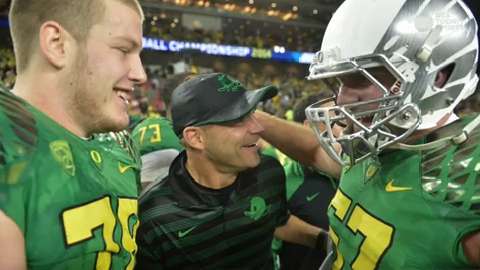Ranking Reaction: Big 12 learns a hard Playoff lesson

The Football Bowl Subdivision houses five major conferences — known as the Power Five, a label created with the advent of the College Football Playoff.
Four of these conferences put their champion in the Playoff. First-ranked Alabama from the Southeastern Conference. Oregon, in second, from the Pac-12. Third-ranked Florida State, still unbeaten, from the Atlantic Coast Conference.
Ohio State's performance in the Big Ten Championship on Saturday lifted the Buckeyes into the top four, vaulting up one spot after a 59-0 win against Wisconsin.
Then there's the Big 12. Co-champions Baylor and TCU — the co-champions, which is a vital point — were left at the altar, with the Horned Frogs plummeting three spots from last week's rankings to sixth and Baylor the first team out of the Playoff picture.
"We think both Baylor and TCU are worthy of being in the four-team playoff," Big 12 commissioner Bob Bowlsby said. "They've got a body of work that's significant. I'd be less than forthright if I didn't say we were extremely disappointed."
In the first season of the Playoff, the Big 12 learned the toughest lesson of all: change, adapt and evolve, or again stand as the odd man out in the championship race.
There are big-picture lessons for the conference; there are also individual lessons for the Horned Frogs and Bears.
Begin with the Big 12, which was dinged by one crucial factor in particular: the lack of a conference championship game.
"It's clear we were penalized for not having a postseason championship game," Bowlsby said. "It would have been nice if we had been told that ahead of time."
Baylor ended conference play at 8-1. Likewise with TCU. According to existing league bylaws, this left the pair as co-champions — which, in turn, left the selection committee without a definitive pick to place alongside the winners of the four remaining major conferences.
"We were presented with co-champions," selection committee chairman Jeff Long said. "In the other situations, we had definitive champions for that conference."
That the Big 12 couldn't present the committee with a clear champion is one reason for the creation of a conference title game, something the league could achieve in one of two ways: one, by adding two teams to reach 12 programs, or two, petitioning for an NCAA waiver allowing for a title game at its current makeup.
The Big 12 had discussions about adding a championship game last winter; the conference, led by Bowlsby, will renew those conversations in earnest during the coming months.
"That will cause us to go back to the drawing board a little bit and think about if we need a different model," Bowlsby said.
There's an even more tangible result to take from the league's lack of a title game: It gave Ohio State one final chance to make its Playoff case — a chance it ran with, providing the final impetus for a move inside the top four.
"It was really about Ohio State's performance," Long said of the Buckeyes' leap, "not Baylor or TCU."
Ohio State had the opportunity for this performance; TCU and Baylor did not. Ohio State played 13 games during the regular season, all coming against members of the FBS. TCU and Baylor were stuck at 12 games. It might stand to reason that Baylor or TCU could have finished ahead of the Buckeyes had they been given a similar chance — with one beating the other to win the Big 12, perhaps.
For Baylor, finishing ahead of the Horned Frogs justifies the head-to-head advantage gained in October's 61-58 win. Finishing behind Ohio State, however, can be blamed on the Bears' flimsy nonconference schedule.
Baylor played Northwestern State, SMU and Buffalo — one a Football Championship Subdivision team, another a one-win team, the third an also-ran in the Mid-American Conference.
After missing out despite holding the best win of any top-six team, against TCU, the Bears must address their future schedules outside of conference play. Unfortunately, the program's nonconference schedules through 2018 have a similar feel.
During the next four years, the Bears have nonconference games against SMU, Lamar, Rice, Northwestern State, Liberty, UTSA and Duke. In comparison, TCU has schedule matchups with Minnesota, Arkansas, Ohio State and California. Baylor needs to adapt.
Bowlsby has talked to the conference athletics directors, he said Sunday, even discussing the scenario where a weak schedule could leave a team in fifth, sixth or seventh in the Playoff rankings.
"I think this is going to be a wake-up call for our schools as well as other schools across the country," Bowlsby said.
The message has been sent from the selection committee — and even if not purposely, sent with a lesson that should change the Big 12 model.
"I can't answer what's best for the Big 12," Long said. "That's not for us to decide."
